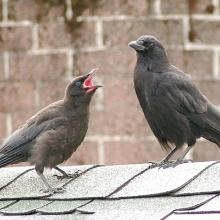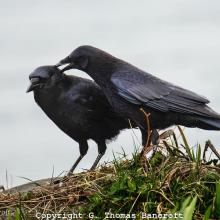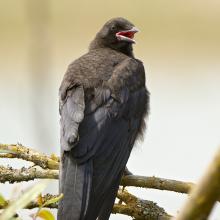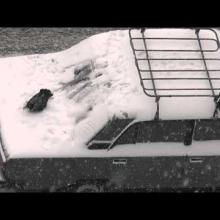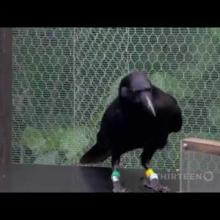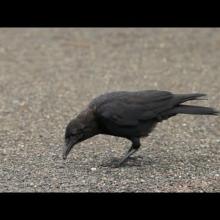

Join BirdNote tomorrow, November 30th!
Illustrator David Sibley and actor H. Jon Benjamin will face off in the bird illustration battle of the century during BirdNote's Year-end Celebration and Auction!
When smaller birds join forces to ward off larger birds, it's called mobbing. This behavior — like calling your family for help — is used by many bird species. The best time to observe mobbing is spring and early summer, when breeding birds are trying to protect their nests and young. Birds including swallows, blackbirds, and even these American Crows, seen here mobbing a Red-tailed Hawk, know that there is strength and power in numbers. And they've learned to join forces to protect themselves. Be sure to watch the video!
BirdNote®
Small Birds Mob Big Ones
Written by Frances Wood
This is BirdNote.
[Crows calling]
Have you ever watched crows dive-bombing a hawk or an eagle? Several crows will gang up and pester a larger bird into departing their breeding territory. Perhaps you’ve seen starlings or blackbirds do the same to crows.
When smaller birds join forces to ward off larger birds, it’s called “mobbing.” This behavior — like calling family members for help — is used by many bird species. The best time to observe mobbing is spring and early summer, when breeding birds are trying to protect their nests and young.
Barn Swallows, which nest near humans, are a good example. [Barn Swallow sounds] If a pair of swallows perceives a threat to their nesting territory, they sound the alarm. Half a dozen neighboring swallows will arrive almost immediately to help scare away the intruder, be it a housecat slinking into the garden or you venturing too close. [Scolding Barn Swallows]
If you hear a ruckus and spot several crows circling and swooping toward a tall conifer, it’s a good bet that there’s a raptor tucked in the tree, a hawk perhaps, or an owl. [Mobbing calls of crows]
These birds know that there’s strength in numbers, and they’ve learned to join forces to protect themselves. [Mobbing calls of crows]
For a link to a video of crows mobbing a Bald Eagle, visit our website, BirdNote.org, I’m Michael Stein.
###
Bird sounds provided by The Macaulay Library at the Cornell Lab of Ornithology, Ithaca, New York. American Crow mobbing sounds [36942] recorded by A.B. Vandeburg. Barn Swallow call [106593] recorded by R.S. Little.
BirdNote’s theme music was composed and played by Nancy Rumbel and John Kessler.
Producer: John Kessler
Executive Producer: Chris Peterson
© 2015 Tune In to Nature.org July 2018/2020 February 2023 Narrator: Michael Stein
ID# mob-01b-2020-7-29 mob-01b




